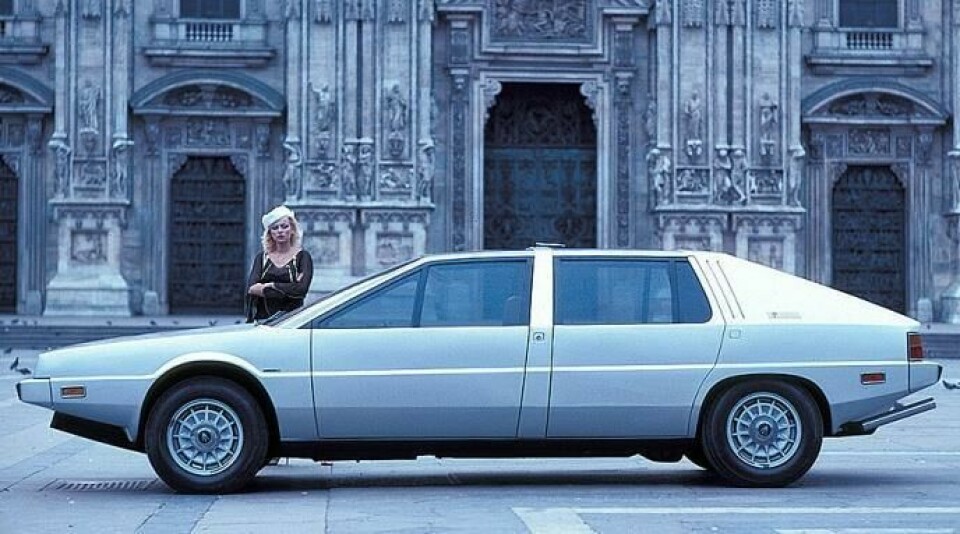
Maserati Medici I (1974) & II (1976)
In 1974, Giorgetto Giugiaro set about transforming the look of the Maserati Quattroporte as he had done previously with Ghibli, Bora, and Merak. Those cars were supercars, racing coupés for the street. Could the same be done for the sedan?
In 1974, Giorgetto Giugiaro set about transforming the look of the Maserati Quattroporte as he had done previously with Ghibli, Bora, and Merak. Those cars were supercars, racing coupés for the street. Could the same be done for the sedan?

The first Maserati Medici. Sedan body, sports car nose
Giugiaro took the chassis of a two-door Maserati Indy and stretched it to accommodate more passengers and create a limousine-type space. A 4.9-litre engine was placed longitudinally in the front, giving the car lots of power.

The car would be named Medici, for the Renaissance-era Florentine banking family of the same name. The name and the family were chosen to connote luxury, status and Italian heritage.
The design of the car was in keeping with the wedge-shaped Italian cars of that era. A strong wedge at the front, followed by an angular but chunky passenger compartment and fast back, made up its two-box composition.

The trapezoidal C-pillar was a very strong element in the design, with its broad base and narrow top.
On the inside, there was seating for six, with four lounge chairs set behind the front two seats. The entire interior was covered in velour for a (very ‘70s) luxury cabin ambiance. However, those lounge chairs made for a tight squeeze when all were in use, a problem that has bedevilled luxury concepts like this ever since.

But it was the exterior that gave so many observers pause. The juxtaposition of the wedge-y front end with the boxy rear made for a jarring contrast. The nose, first seen on Maserati’s 2+2 concept (the successor to the Indy) just didn’t look substantial enough for the limousine cabin and fastback rear end. When shown at the 1974 Turin Motor Show, the reviews were decidedly mixed.
Even Giugiaro would agree with the critics and admit it was a rare design misstep.
Take II

The second Maserati Medici was a more balanced composition
But Giugiaro would get a rare chance at redemption the next year. He brought the Medici back to Italdesign and redesigned both the front end and the interior to create a completely new car. The wedge at the front was modified to accept a rectangular fascia and quad rectangular lights. The bonnet still sloped downwards, but to a less dramatic degree. The horizontal character line, so prominent at the cabin and over the rear wheels, was extended and tied into the front bumper.

The revised Maserati Medici interior – Executive-class luxury
At the interior, the awkward seating was replaced by a four-seat arrangement, with the rear seat a pair of side-by-side lounge chairs. The limousine feel of the cabin was reinforced by acres of Italian leather and C-suite appointments like cabinets containing a mini-bar, a refrigerator, a desk, a TV and a stereo. Two glazed roof panels overhead let in plenty of Italian sunshine. Silver paint and a brown leather interior made for a more classic executive car look.

The revised profile was considered much improved
The Medici II was introduced (or re-introduced, as it were) at the Paris Motor Show in 1976. The reception was much improved over that of Medici I, with many noting that while the sports car/wedge styling was compromised in the redesign of the car, the classic looks and executive character of the Medici were much enhanced.

The Medici II at an early morning photo shoot at the Milan Cathedral
Many of the photos here were taken by Rainer Schlegelmilch, who established his reputation as the premier Formula 1 photographer of the 1970s and ‘80s. He also took some of the most iconic photos of classic Italian cars of the wedge era. For the Medici II, the site was the courtyard of the Duomo in Milan (interestingly, the city of the Viscounts and Sforzas, not the Medicis). Here with a fashion model and a gaggle of slack-jawed on-lookers, Schlegelmilch captured the bold, elegant presence of the Medici II, even in such a classic architectural setting. The Medici car with its clean, trapezoidal geometries seemed the perfect foil for the Gothic cathedral beyond.

Bold geometry in a historic setting
The Medici did not go into production, but it influenced many cars that would come in the years shortly after. Most immediately, its influence could be seen in the third-generation Maserati Quattroporte introduced the same year. The design also trickled down to the Audi 80, the Lancia Delta, and even the Hyundai Pony, among others.

The DeLorean - a two door Medici?
But, as many designers notice immediately, it is the DeLorean DMC-12 that most strongly carried the styling cues of the Medici II forward. Indeed, the DeLorean has been very accurately described as a two-door Medici.
As for the Medici car itself, it was sold to the Shan of Iran, who had a passion for Maseratis, and ultimately went to the Louwman Collection in The Hague where it resides today.

Life seldom provides us with a chance for a do-over. When one is presented, it is best to bring every bit of talent and energy to the opportunity. Giugiaro did just that with the Medici, and a generation of sedans, luxury liners, sports cars, and even economy cars, was the better for it.



